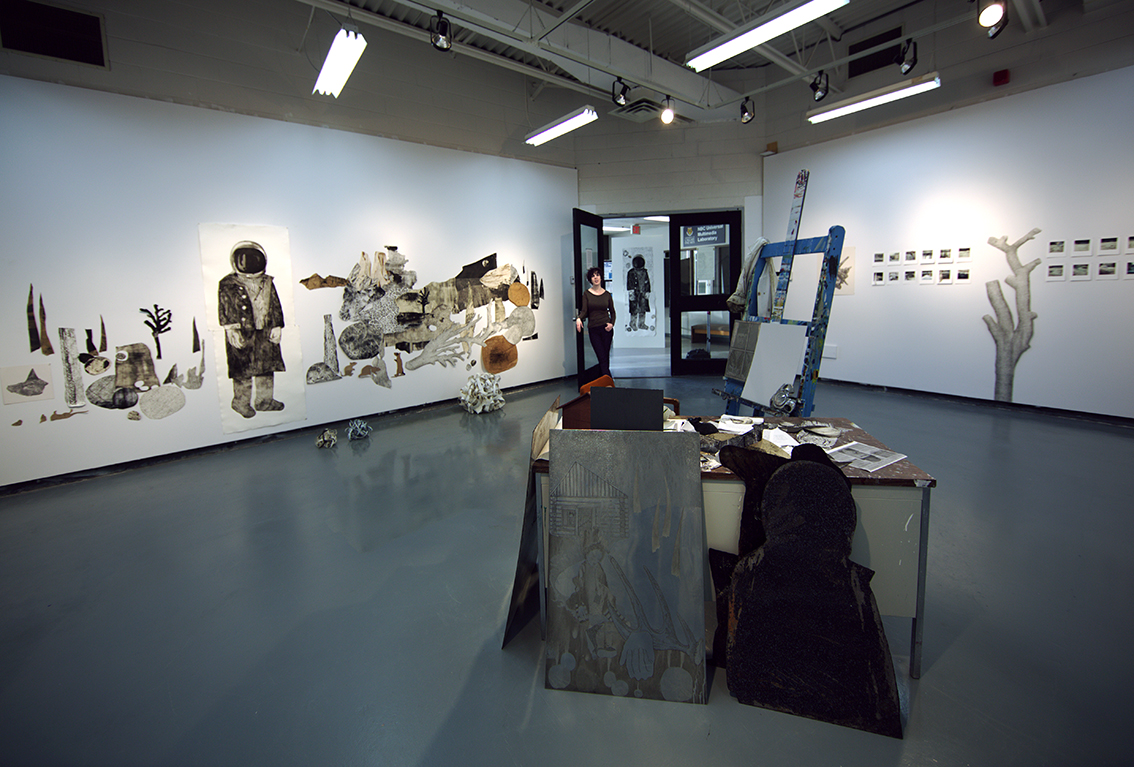
Journey (2013)
A visual diary of a journey into the unknown, made during an artist residency at the University of Calgary.
Investigating the life of things across space and time
Extract from Somewhere (1969); Walter de la Mare
Etchings, monoprints and drawings by Sarah Gillett
Hamelin is a rag puppet doll just under a metre in height that I took with me to Canada. She appears in So pass away the old timers, one by one as my alter ego.
Multiplied through the process of etching, she exists in more than one dimension of space. She is also dressed as a fool: mischievous, bold, lost, never fitting in to the time she occupies or with the people around her. Everything about her is strange, to them and to herself.
The falling figure is a recurring image in my work. It represents a loss of control, depicting a body in its most vulnerable state. There is nothing to cling onto here. There is only space, a separateness from everything and everyone else in the world.
The Unsound House is precarious, built on an idea of a cabin built by the first white settler in Calgary, an Irishman named John Glenn. It is a unique monoprinted house, 3 metres by 3 metres.
John Glenn’s cabin was built on uncertain ground; at the convergence of Fish Creek and Bow River on land used by the Blackfoot, First Nations people of the Plains, for around 8,000 years (there are three tribes of the Blackfoot in Alberta: Siksika, Piikani [Peigan] and Kainaiwa [Blood]. Each of these tribes is independent, but they all speak the same language and regard themselves as allies).
The Fish Creek valley was formed at the end of the last Ice Age, carved by meltwater from retreating glaciers in the mountains to the west. Fish Creek itself is now an underfit stream; that is, its current flow rates are not great enough to have carved the valley through which it flows.
The bedrock exposed in the lower parts of the valley consists of sandstones, siltstones, and mudstones of early Paleocene age. They belong to the upper part of the Willow Creek Formation, which grades into the upper Scollard Formation in the Calgary area.
The unconsolidated sediments that overlie the bedrock are exposed in some of the cliffs along the upper edges of the valley. They may include glacial till at the base, overlain by post-glacial stream deposits, loess, and paleosols, and are topped by recent soil horizons. The Mazama Ash, a layer of white volcanic ash a few centimetres thick, can be seen within these sediments in a few places. The Mazama Ash was produced during the eruption that formed Crater Lake in south-central Oregon. It was spread to the north and east by the prevailing winds, and remnants of it have been identified as far east as the Greenland ice sheet.
In 1999 John Glenn’s cabin was dismantled by the Archeology Field Studies Team of the University of Calgary with the intention of reconstructing the building in its original site. Since then funding for this project was withdrawn, so the pieces of the cabin still sit silently in storage.
As a result of the heavy rains and floods experienced by Alberta in June 2005, half of the park’s trails were washed away, and the other half were damaged. Seven pedestrian bridges over Fish Creek were destroyed and seven others were rendered unsafe. The park reopened in September 2007 following the construction of new bridges and a redesigned pathway system. Then in June 2013 the park was damaged again by severe flooding, leaving debris in its wake. Once more bridges and paths had to be repaired and strengthened, demonstrating the power of nature over any human attempt to tame it.
Build your own mini Unsound House here.

A visual diary of a journey into the unknown, made during an artist residency at the University of Calgary.

Accidental large scale collage created from the process of making other work: offcuts, leftovers, rejects and stencils at the end of their lives, having been printed, pressed, battered and cut into multiple times.

An exhibition of printmaking, collage and drawing about barren landscapes, distance and time.

Drawings from my collection for the exhibition So pass away the old timers, one by one. Wood, fossil and fool’s gold.

The dogs in south London are running. One of the big ones slows down as it passes me and I step back as its nose swerves into my crotch, waving my arms as though that would make any difference. If it were really hungry it would just eat me but I get a face full of hot meaty air and it’s a lucky day.

The past and the future redrawn in the present. In this ongoing series, collage, paint, pencil, crayon, print and thread subvert original postcards dated 1897-now, creating new lived experiences.

Anachronistic pixelated images created on the ancient matrix of the loom. Interventions into vintage needleworks, cut and reworked into ruinous tapestries.
Sarah Gillett is an artist and writer from Lancashire, UK.
She currently lives in London.